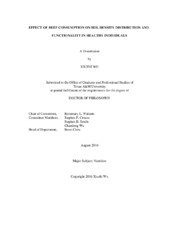| dc.description.abstract | The adverse health associations reported for red meat may be attributed to increased saturated fatty acid (SFA) intake. This project aims to evaluate the effects of beef fatty acid composition and lean beef on atherosclerotic cardiovascular disease (ASCVD) risks in two healthy populations.
Study 1:
Twenty-five normocholesterolemic men consumed in random order: 5-114 g, 24% fat beef patty/wk for 5 wk of both low (M:S = 0.71) and high monounsaturated fatty acid (MUFA) (M:S = 1.10) beef patties (~40 EN% fat diet). Increased beef consumption had no effect on circulating adipokines, homocysteine, paraoxonase1 (PON1) activity, HDL density distribution and HDL3 apolipoprotein composition. Independent of fatty acid composition, beef consumption reduced HOMA-IR scores and the pro-inflammatory 5-keto-eicosatetraenoic acid (5-KETE) in HDL (P <0.05). The changes were positively correlated with baseline HDL-C and negatively correlated with baseline HDL EPA status respectively (P <0.05). Overall beef consumption increased HDL3 sphingosine-1-phophate (S1P) (P <0.05) and this change was negatively correlated with baseline triglyceride, total cholesterol, LDL-C and HDL3 ApoE (P <0.01).
Study 2:
Twenty-seven mildly hypercholesterolemic subjects consumed in random order: Healthy American diet (HAD), Dietary Approaches to Stop Hypertension (DASH), Beef in an Optimal Lean Diet (BOLD) and BOLD plus extra protein (BOLD+) (20, 28, 113, 153 g lean beef/d, respectively, all diets ~30 EN% fat) for 5 wk. The BOLD+ diet reduced absolute and fractional abundance of small LDL4 (P <0.05) relative to HAD. Baseline HOMA-IR was strongly associated with LDL4 responsiveness to the DASH (P = 0.003) and BOLD diets (P = 0.018). LDL4 decreased after the BOLD (P = 0.003) and BOLD+ (P = 0.046), but not DASH (P = 0.069) diets in the low baseline HOMA-IR group. The high baseline HOMA-IR group tended to show favorable changes in LDL4 only after the BOLD+ diet (P = 0.078) with a significant dietary effect observed (P = 0.013).
Our studies showed that individual response to beef intervention, regardless of beef fatty acid composition or total fat, is influenced by baseline health status. In healthy individuals, increased beef consumption may have a favorable effect on ASCVD risk factors. | en |


